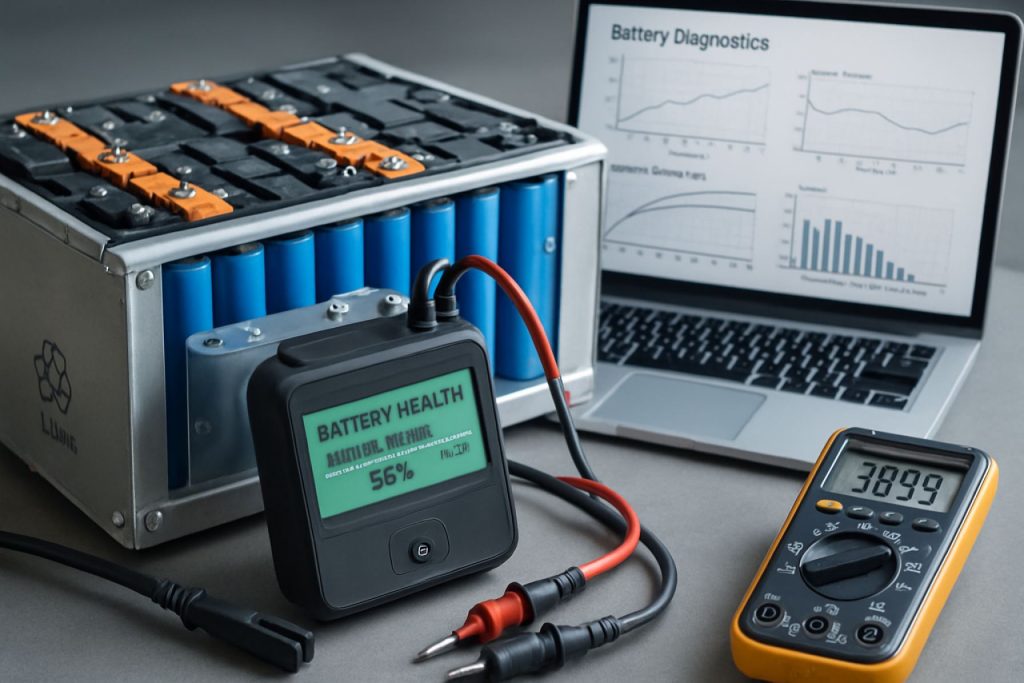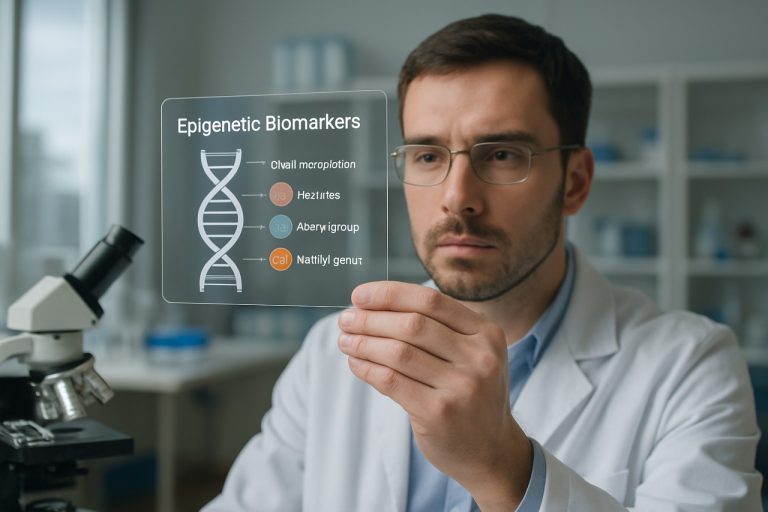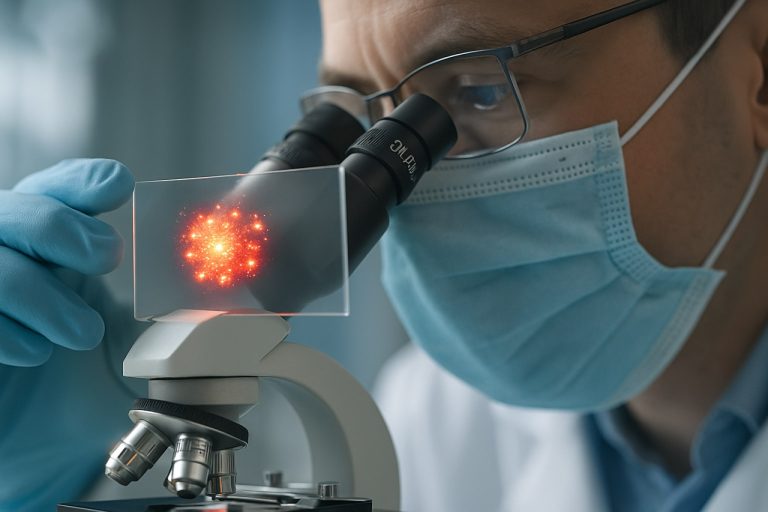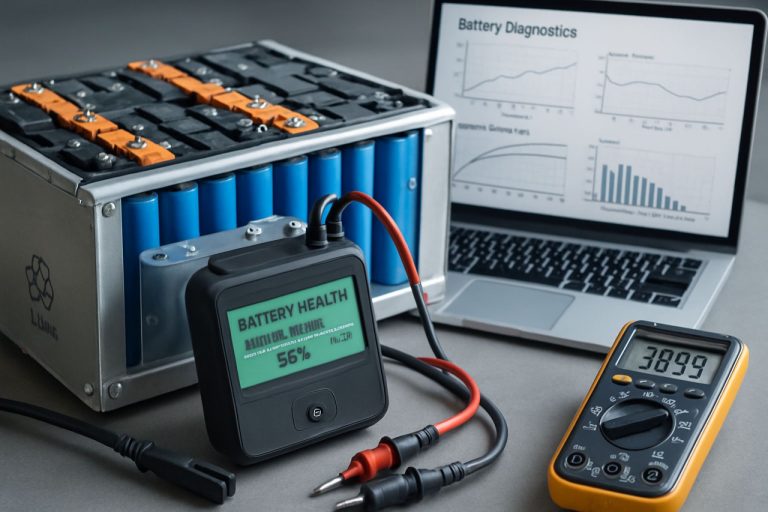
Unlocking the Future of Lithium-Ion Battery Health Diagnostics in 2025: Market Growth, Breakthrough Technologies, and Strategic Insights for the Next Five Years
- Executive Summary: 2025 Market Landscape and Key Drivers
- Market Size, Growth Forecasts, and CAGR Analysis (2025–2030)
- Emerging Diagnostic Technologies: AI, IoT, and Advanced Sensors
- Competitive Landscape: Leading Players and Strategic Initiatives
- Regulatory Standards and Industry Guidelines (e.g., IEEE, IEC)
- Application Sectors: Automotive, Grid Storage, Consumer Electronics, and More
- Challenges: Data Accuracy, Standardization, and Lifecycle Management
- Recent Innovations and Patent Activity
- Strategic Partnerships, M&A, and Investment Trends
- Future Outlook: Opportunities, Risks, and Disruptive Trends to 2030
- Sources & References
Executive Summary: 2025 Market Landscape and Key Drivers
The lithium-ion battery health diagnostics sector is poised for significant growth and transformation in 2025, driven by the rapid expansion of electric vehicles (EVs), grid-scale energy storage, and portable electronics. As global electrification accelerates, the need for advanced diagnostic solutions to monitor, predict, and extend battery life has become a critical priority for manufacturers, fleet operators, and end-users. The market landscape in 2025 is characterized by a convergence of technological innovation, regulatory momentum, and strategic investments from leading industry players.
Key drivers shaping the market include the proliferation of EVs, with automakers such as Tesla, Inc., BYD Company Limited, and LG Energy Solution integrating sophisticated battery management systems (BMS) that leverage real-time diagnostics to ensure safety, performance, and warranty compliance. These systems utilize embedded sensors, advanced algorithms, and cloud connectivity to monitor state-of-health (SOH), state-of-charge (SOC), and early signs of degradation or failure. In parallel, battery manufacturers like Panasonic Corporation and Samsung SDI are investing in diagnostic technologies to support second-life applications and recycling, addressing both sustainability and cost-effectiveness.
The regulatory environment is also evolving, with regions such as the European Union and China introducing stricter requirements for battery safety, traceability, and end-of-life management. This is prompting OEMs and suppliers to adopt more robust diagnostic protocols and data transparency measures. Industry bodies, including the SAE International and IEEE, are actively developing standards for battery health assessment, interoperability, and data sharing, which are expected to influence product development and market adoption through 2025 and beyond.
Looking ahead, the next few years will see increased collaboration between battery producers, automotive OEMs, and technology firms to develop AI-driven predictive maintenance tools and digital twin platforms. Companies such as Contemporary Amperex Technology Co., Limited (CATL) and Robert Bosch GmbH are at the forefront of integrating machine learning and big data analytics into their diagnostic offerings, aiming to reduce downtime, optimize lifecycle costs, and enhance user confidence. The sector is also witnessing the emergence of specialized startups and partnerships focused on cloud-based diagnostics and remote monitoring, further expanding the ecosystem.
In summary, 2025 marks a pivotal year for lithium-ion battery health diagnostics, with market growth underpinned by technological advancements, regulatory shifts, and the strategic priorities of major industry stakeholders. The outlook remains robust, with ongoing innovation expected to deliver safer, longer-lasting, and more sustainable battery solutions across multiple sectors.
Market Size, Growth Forecasts, and CAGR Analysis (2025–2030)
The global market for lithium-ion battery health diagnostics is poised for significant expansion between 2025 and 2030, driven by the accelerating adoption of electric vehicles (EVs), grid-scale energy storage, and portable electronics. As battery systems become more integral to critical infrastructure and transportation, the demand for advanced diagnostic solutions—encompassing hardware, software, and cloud-based analytics—continues to rise. Key industry players, including Tesla, Inc., Panasonic Corporation, LG Energy Solution, and Contemporary Amperex Technology Co., Limited (CATL), are investing heavily in battery management systems (BMS) and diagnostic technologies to ensure safety, longevity, and performance of their lithium-ion products.
In 2025, the market size for lithium-ion battery health diagnostics is estimated to be in the multi-billion dollar range, with robust growth anticipated through 2030. This growth is underpinned by the rapid scaling of EV production—global EV sales surpassed 10 million units in 2023 and are projected to continue rising sharply, directly increasing the installed base of batteries requiring ongoing health monitoring. Major automotive OEMs and battery manufacturers are integrating advanced diagnostics into their platforms, leveraging real-time data analytics, machine learning, and cloud connectivity to predict battery degradation, optimize charging cycles, and prevent failures.
The compound annual growth rate (CAGR) for the lithium-ion battery health diagnostics sector is expected to exceed 15% during the 2025–2030 period, outpacing the broader battery market. This is fueled by regulatory pressures for battery safety and extended warranties, as well as the need for second-life and recycling applications, which require precise state-of-health (SOH) assessments. Companies such as Samsung SDI and BYD Company Limited are developing proprietary diagnostic algorithms and collaborating with software providers to enhance their BMS offerings.
Looking ahead, the market outlook remains highly favorable. The proliferation of stationary storage projects, particularly in North America, Europe, and Asia-Pacific, is expected to further drive demand for sophisticated diagnostic solutions. Industry initiatives, such as those led by International Energy Agency (IEA) and battery alliances, are also fostering standardization and interoperability, which will support market growth. As digitalization and artificial intelligence become more deeply embedded in battery management, the lithium-ion battery health diagnostics market is set to play a pivotal role in the global energy transition through 2030 and beyond.
Emerging Diagnostic Technologies: AI, IoT, and Advanced Sensors
The landscape of lithium-ion battery health diagnostics is undergoing rapid transformation in 2025, driven by the integration of artificial intelligence (AI), Internet of Things (IoT) connectivity, and advanced sensor technologies. These innovations are addressing the growing demand for accurate, real-time monitoring of battery state-of-health (SoH), state-of-charge (SoC), and predictive maintenance, particularly as electric vehicles (EVs), grid storage, and consumer electronics proliferate.
AI-powered diagnostic algorithms are now being embedded directly into battery management systems (BMS), enabling continuous learning from operational data and more precise estimation of battery degradation. Major battery manufacturers such as LG Energy Solution and Panasonic Corporation are actively developing and deploying AI-driven BMS platforms that leverage machine learning to analyze voltage, current, and temperature data, providing early warnings of potential failures and optimizing charging protocols for extended battery life.
IoT connectivity is further enhancing diagnostic capabilities by enabling remote monitoring and fleet-level analytics. Companies like Contemporary Amperex Technology Co., Limited (CATL) and Samsung SDI are equipping their battery packs with wireless communication modules, allowing real-time data transmission to cloud-based platforms. This connectivity supports predictive maintenance strategies, where anomalies can be detected and addressed before they escalate into critical issues, reducing downtime and operational costs for EV fleets and stationary storage systems.
Advanced sensor technologies are also playing a pivotal role in the evolution of battery diagnostics. Beyond traditional voltage and temperature sensors, manufacturers are integrating impedance spectroscopy, fiber optic sensors, and micro-electromechanical systems (MEMS) to capture granular data on internal battery conditions. Tesla, Inc. is known to invest in proprietary sensor arrays and diagnostic software, aiming to maximize the lifespan and safety of its battery packs through continuous, high-resolution monitoring.
Looking ahead, the convergence of AI, IoT, and advanced sensors is expected to enable even more sophisticated diagnostic solutions. Industry leaders are collaborating with automotive OEMs and energy utilities to standardize data protocols and develop interoperable platforms, facilitating ecosystem-wide health management. As regulatory bodies increasingly mandate transparency and safety in battery systems, these emerging technologies are poised to become industry standards, driving improvements in reliability, sustainability, and user confidence across the lithium-ion battery value chain.
Competitive Landscape: Leading Players and Strategic Initiatives
The competitive landscape for lithium-ion battery health diagnostics in 2025 is characterized by rapid innovation, strategic partnerships, and increasing integration of advanced analytics and artificial intelligence (AI) into battery management systems. As electric vehicles (EVs), grid storage, and portable electronics continue to proliferate, the demand for accurate, real-time battery health diagnostics has intensified, prompting both established industry leaders and specialized technology firms to invest heavily in this domain.
Among the most prominent players, Panasonic Corporation and LG Energy Solution have expanded their battery management system (BMS) offerings to include sophisticated health monitoring features. These systems leverage embedded sensors and cloud connectivity to provide continuous diagnostics, enabling predictive maintenance and extending battery life. Panasonic Corporation has announced ongoing development of AI-driven diagnostic algorithms, aiming to enhance the accuracy of state-of-health (SOH) estimations and early detection of cell degradation.
Similarly, Samsung SDI has integrated advanced diagnostic capabilities into its battery packs, focusing on real-time data analytics and remote monitoring. The company’s strategic collaborations with automotive OEMs are expected to accelerate the deployment of these technologies in next-generation EVs. Contemporary Amperex Technology Co., Limited (CATL), the world’s largest lithium-ion battery manufacturer, is also investing in proprietary diagnostic platforms that utilize big data and machine learning to optimize battery performance and safety.
In the automotive sector, Tesla, Inc. continues to refine its in-house battery health diagnostics, leveraging its vertically integrated approach to hardware and software. Tesla’s vehicles are equipped with over-the-air update capabilities, allowing for continuous improvement of diagnostic algorithms and real-time health reporting to users. This approach not only enhances user experience but also supports Tesla’s battery recycling and second-life initiatives.
Beyond cell manufacturers and automakers, technology firms such as Robert Bosch GmbH are developing modular diagnostic solutions for both stationary and mobile applications. Bosch’s systems are designed to be compatible with a wide range of battery chemistries and form factors, supporting the broader electrification of transport and energy sectors.
Looking ahead, the competitive landscape is expected to see further consolidation and collaboration, as companies seek to standardize diagnostic protocols and integrate health monitoring across the battery value chain. The convergence of IoT, AI, and cloud computing is poised to drive the next wave of innovation, with leading players positioning themselves to capture value in both hardware and data-driven services.
Regulatory Standards and Industry Guidelines (e.g., IEEE, IEC)
The regulatory landscape for lithium-ion battery health diagnostics is rapidly evolving as the global adoption of electric vehicles (EVs), grid storage, and portable electronics accelerates. In 2025, international standards bodies and industry consortia are intensifying efforts to harmonize diagnostic protocols, safety requirements, and data reporting frameworks to ensure battery reliability, safety, and interoperability across applications.
The Institute of Electrical and Electronics Engineers (IEEE) continues to play a pivotal role, with standards such as IEEE 1725 and IEEE 1625, which address battery system safety and reliability for portable devices. These standards are being updated to reflect advances in state-of-health (SOH) estimation, fault detection, and predictive analytics, incorporating learnings from recent field failures and new diagnostic technologies. The IEEE is also working on new guidelines for battery management systems (BMS) communication protocols, which are critical for real-time health monitoring and reporting.
On the international front, the International Electrotechnical Commission (IEC) is advancing the IEC 62660 series, which specifies performance and reliability testing for lithium-ion cells used in EVs. The latest revisions emphasize standardized diagnostic test methods, including impedance spectroscopy and capacity fade analysis, to enable consistent SOH assessment across manufacturers. The IEC is also collaborating with automotive and energy storage stakeholders to develop guidelines for end-of-life diagnostics and second-life battery applications, reflecting the growing importance of circular economy principles.
In parallel, the SAE International is updating its J2950 and J2289 standards, focusing on battery diagnostics for hybrid and electric vehicles. These standards are increasingly referenced by automakers and suppliers to ensure that onboard diagnostic systems can accurately detect degradation, thermal anomalies, and safety-critical faults. The SAE is also working with industry partners to define minimum data sets and reporting formats for battery health, supporting regulatory compliance and warranty management.
Industry alliances such as the Charging Interface Initiative e.V. (CharIN) and the Global Battery Alliance are contributing to the development of interoperable diagnostic frameworks and data-sharing protocols. These efforts aim to facilitate cross-platform health monitoring, support battery passport initiatives, and enable transparent lifecycle tracking.
Looking ahead, regulatory agencies in key markets—including the European Union, United States, and China—are expected to introduce stricter mandates for battery health diagnostics, particularly for EVs and stationary storage. This will likely drive further convergence of standards and accelerate the adoption of advanced diagnostic technologies, such as AI-driven analytics and cloud-based monitoring, across the lithium-ion battery value chain.
Application Sectors: Automotive, Grid Storage, Consumer Electronics, and More
Lithium-ion battery health diagnostics are becoming increasingly critical across multiple application sectors, including automotive, grid storage, and consumer electronics, as the global reliance on rechargeable batteries intensifies in 2025 and beyond. The automotive sector, led by major electric vehicle (EV) manufacturers such as Tesla, Inc., BYD Company Ltd., and Volkswagen AG, is at the forefront of integrating advanced battery management systems (BMS) that continuously monitor and assess battery health. These systems utilize real-time data analytics, impedance spectroscopy, and machine learning algorithms to predict battery degradation, optimize charging cycles, and extend battery lifespan. For instance, Tesla, Inc. employs proprietary software to track cell-level performance, enabling over-the-air updates that enhance diagnostic accuracy and user experience.
In grid storage, companies such as LG Energy Solution and Contemporary Amperex Technology Co. Limited (CATL) are deploying large-scale lithium-ion battery systems for renewable energy integration and grid stabilization. Here, health diagnostics are essential for ensuring safety, maximizing uptime, and managing warranty obligations. These companies are investing in remote monitoring platforms that aggregate data from thousands of battery modules, using predictive analytics to identify early signs of cell imbalance, thermal runaway, or capacity fade. The trend toward digital twins—virtual replicas of physical battery systems—enables operators to simulate aging and stress scenarios, further improving reliability and reducing operational costs.
Consumer electronics manufacturers, including Apple Inc. and Samsung Electronics Co., Ltd., are also advancing battery health diagnostics at the device level. Modern smartphones, laptops, and wearables now feature embedded diagnostics that inform users about battery condition, recommend optimal charging practices, and trigger service alerts when degradation thresholds are reached. These diagnostics are increasingly transparent, with user-facing interfaces that display battery health metrics and anticipated service life, reflecting growing consumer demand for device longevity and sustainability.
Looking ahead, the next few years are expected to see further convergence of hardware and software innovations in battery health diagnostics. Cross-sector collaboration is accelerating, with automotive, grid, and consumer electronics companies partnering with battery analytics specialists and component suppliers to standardize diagnostic protocols and data formats. The adoption of artificial intelligence and cloud-based analytics is poised to deliver even more accurate, real-time insights, supporting predictive maintenance and circular economy initiatives. As regulatory bodies and industry groups push for greater transparency and safety, robust battery health diagnostics will remain a cornerstone of lithium-ion battery deployment across all major sectors.
Challenges: Data Accuracy, Standardization, and Lifecycle Management
Lithium-ion battery health diagnostics are increasingly critical as electric vehicles (EVs), grid storage, and portable electronics proliferate. However, the sector faces persistent challenges in data accuracy, standardization, and lifecycle management, which are expected to shape industry priorities through 2025 and beyond.
A primary challenge is the accuracy of battery health data. Battery management systems (BMS) rely on a combination of voltage, current, temperature, and sometimes impedance measurements to estimate state-of-health (SoH) and state-of-charge (SoC). However, these estimations are often affected by sensor drift, environmental conditions, and cell-to-cell variability. Leading manufacturers such as Panasonic and LG Energy Solution are investing in advanced algorithms and sensor technologies to improve diagnostic precision, but real-world accuracy remains a concern, especially as batteries age and degrade in unpredictable ways.
Standardization is another major hurdle. The lack of universally accepted protocols for battery health diagnostics complicates interoperability and data sharing across the value chain. Organizations like SAE International and IEEE are working on standards for battery testing and data formats, but adoption is uneven and often lags behind technological advances. This fragmentation makes it difficult for automakers, battery suppliers, and recyclers to exchange reliable health data, impeding efforts to establish robust second-life and recycling markets.
Lifecycle management is also under scrutiny. As batteries move from first use in vehicles to potential second-life applications (such as stationary storage), accurate health diagnostics are essential for determining residual value and safety. Companies like Tesla and Contemporary Amperex Technology Co., Limited (CATL) are developing proprietary diagnostic tools to track battery health throughout the lifecycle, but the lack of standardized data formats and diagnostic criteria complicates cross-industry collaboration. Furthermore, regulatory bodies in Europe and Asia are beginning to require more transparent battery health reporting, adding urgency to the need for harmonized approaches.
Looking ahead to 2025 and the following years, the industry is expected to intensify efforts to address these challenges. Initiatives to improve sensor accuracy, develop open data standards, and implement digital battery passports are gaining momentum. However, progress will depend on collaboration among manufacturers, standards organizations, and regulators. Without significant advances in data accuracy, standardization, and lifecycle management, the full potential of lithium-ion battery health diagnostics—and by extension, the circular battery economy—will remain constrained.
Recent Innovations and Patent Activity
The field of lithium-ion battery health diagnostics has experienced significant innovation and patent activity in 2025, driven by the rapid expansion of electric vehicles (EVs), grid storage, and portable electronics. As battery longevity and safety become critical differentiators, manufacturers and technology providers are investing heavily in advanced diagnostic solutions that can accurately assess battery state-of-health (SOH), predict remaining useful life (RUL), and detect early signs of degradation or failure.
A major trend in 2025 is the integration of embedded sensors and edge computing within battery management systems (BMS). Companies such as Panasonic Corporation and LG Energy Solution have announced new BMS platforms that utilize real-time impedance spectroscopy, temperature mapping, and machine learning algorithms to provide granular health diagnostics at the cell and pack level. These systems are designed to enable predictive maintenance and extend battery service life, with several patents filed around proprietary data analytics and sensor fusion techniques.
Another area of innovation is non-invasive diagnostic methods. Tesla, Inc. has continued to refine its over-the-air (OTA) diagnostic capabilities, leveraging vehicle telemetry and cloud-based analytics to monitor battery health remotely. In 2025, Tesla has been granted patents related to adaptive diagnostic algorithms that adjust to user driving patterns and environmental conditions, enhancing the accuracy of SOH predictions. Similarly, Samsung SDI has disclosed new approaches for in-situ battery monitoring using acoustic and ultrasonic sensing, with patent filings focused on signal processing methods that detect microstructural changes in real time.
Collaborative efforts are also evident, with industry consortia such as SAE International and IEEE working to standardize diagnostic protocols and data formats. These standards aim to facilitate interoperability between diagnostic tools and battery systems from different manufacturers, a key requirement as second-life and recycling markets expand. Patent activity in this area includes methods for secure data sharing and anonymized health reporting.
Looking ahead, the outlook for lithium-ion battery health diagnostics is robust. The convergence of AI, advanced sensing, and cloud connectivity is expected to yield even more sophisticated diagnostic platforms. Companies such as Contemporary Amperex Technology Co. Limited (CATL) are investing in digital twin models and blockchain-based health records, with several patent applications pending in 2025. As regulatory scrutiny on battery safety intensifies, the pace of innovation and patent filings in this sector is projected to accelerate further in the coming years.
Strategic Partnerships, M&A, and Investment Trends
The landscape of lithium-ion battery health diagnostics is rapidly evolving, driven by a surge in strategic partnerships, mergers and acquisitions (M&A), and targeted investments. As the global demand for electric vehicles (EVs), grid storage, and portable electronics intensifies, stakeholders across the battery value chain are prioritizing advanced diagnostic solutions to ensure safety, longevity, and performance.
In 2025, major battery manufacturers and automotive OEMs are deepening collaborations with technology firms specializing in battery analytics and diagnostics. Panasonic Corporation, a leading battery supplier, has expanded its alliances with software and AI companies to integrate real-time health monitoring into its battery management systems. Similarly, LG Energy Solution is investing in partnerships with sensor and data analytics startups to enhance predictive maintenance capabilities for both EV and stationary storage applications.
Strategic M&A activity is also reshaping the sector. In recent years, Robert Bosch GmbH has acquired stakes in firms developing advanced battery diagnostics, aiming to embed these technologies into its automotive and industrial solutions. Meanwhile, Contemporary Amperex Technology Co. Limited (CATL), the world’s largest battery manufacturer, has announced joint ventures with diagnostic technology providers to co-develop next-generation battery health assessment tools, focusing on AI-driven state-of-health (SOH) estimation and early fault detection.
Investment trends in 2025 indicate a strong influx of capital into battery health diagnostics startups. Samsung SDI has launched a dedicated venture fund to support early-stage companies working on novel diagnostic sensors and cloud-based analytics platforms. This move is mirrored by Tesla, Inc., which continues to invest in proprietary battery health monitoring technologies and has signaled openness to external collaborations to accelerate innovation in this domain.
Industry bodies such as the SAE International are facilitating pre-competitive consortia, bringing together automakers, battery suppliers, and technology developers to standardize diagnostic protocols and data sharing frameworks. These initiatives are expected to foster interoperability and accelerate the adoption of advanced diagnostics across the industry.
Looking ahead, the next few years will likely see further consolidation as established players seek to secure technological leadership and new entrants leverage partnerships to scale their solutions. The convergence of AI, IoT, and cloud computing with battery diagnostics is anticipated to drive both investment and M&A activity, positioning battery health diagnostics as a critical enabler of the electrification era.
Future Outlook: Opportunities, Risks, and Disruptive Trends to 2030
The future of lithium-ion battery health diagnostics is poised for significant transformation through 2030, driven by the rapid expansion of electric vehicles (EVs), grid storage, and portable electronics. As battery systems become more integral to critical infrastructure and mobility, the demand for accurate, real-time health diagnostics is intensifying. In 2025 and the coming years, several key opportunities, risks, and disruptive trends are emerging.
- Opportunities: The proliferation of EVs and stationary storage is accelerating the adoption of advanced battery management systems (BMS) with embedded diagnostics. Leading manufacturers such as Panasonic, LG Energy Solution, and Contemporary Amperex Technology Co. Limited (CATL) are investing in smart BMS platforms that leverage machine learning and cloud connectivity to monitor state-of-health (SOH), state-of-charge (SOC), and predict remaining useful life (RUL). These systems enable predictive maintenance, reduce warranty costs, and enhance safety, creating new value streams for OEMs and fleet operators.
- Risks: As diagnostic systems become more complex, cybersecurity and data privacy risks are rising. The integration of cloud-based analytics and remote monitoring exposes battery systems to potential cyber threats. Additionally, the lack of standardized diagnostic protocols across manufacturers could hinder interoperability and data sharing, complicating second-life applications and recycling. Regulatory bodies such as the SAE International and IEEE are working to address these gaps, but harmonization remains a challenge.
- Disruptive Trends: The next few years will see the emergence of non-invasive diagnostic techniques, such as ultrasonic sensing and advanced impedance spectroscopy, which promise higher accuracy and faster assessment without dismantling battery packs. Companies like Tesla, Inc. are reportedly developing proprietary algorithms for real-time health estimation, integrating data from vehicle telematics and cloud platforms. Furthermore, the rise of digital twins—virtual replicas of battery systems—enables continuous simulation and optimization, a trend being explored by major automotive and energy storage players.
- Outlook to 2030: By the end of the decade, battery health diagnostics are expected to be fully integrated into the circular economy, supporting efficient reuse, repurposing, and recycling. Industry-wide adoption of standardized diagnostic data formats and protocols will be critical. The convergence of AI, IoT, and edge computing will further enhance diagnostic precision, reduce costs, and unlock new business models in battery leasing and energy-as-a-service.
In summary, the period from 2025 to 2030 will be marked by rapid innovation and scaling of lithium-ion battery health diagnostics, with leading manufacturers and industry bodies shaping the landscape through technology, standards, and ecosystem collaboration.
Sources & References
- BYD Company Limited
- IEEE
- Contemporary Amperex Technology Co., Limited (CATL)
- Robert Bosch GmbH
- International Energy Agency (IEA)
- Charging Interface Initiative e.V. (CharIN)
- Volkswagen AG
- Apple Inc.



